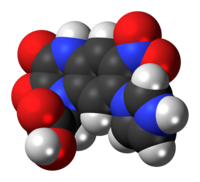 | |
 | |
| Clinical data | |
|---|---|
| ATC code |
|
| Identifiers | |
| |
| CAS Number | |
| PubChem CID | |
| ChemSpider | |
| UNII | |
| CompTox Dashboard (EPA) | |
| Chemical and physical data | |
| Formula | C13H9N5O6 |
| Molar mass | 331.244 g·mol−1 |
| 3D model (JSmol) | |
| |
| |
Zonampanel (INN, code name YM872) is a quinoxalinedione derivative drug and competitive antagonist of the AMPA receptor which was being investigated by Yamanouchi/Astellas Pharma as a neuroprotective drug for the treatment of ischemic stroke but never completed clinical trials.[1][2][3][4] In clinical trials, zonampanel produced severe side effects including hallucinations, agitation, and catatonia in patients, resulting in early termination of the trials.[5]
References[edit]
- ^ Jain KK (14 February 2011). The Handbook of Neuroprotection. Springer Science & Business Media. pp. 154–. ISBN 978-1-61779-049-2.
- ^ Ray A, Gulati K (1 January 2007). Current Trends in Pharmacology. I. K. International Pvt Ltd. pp. 321–. ISBN 978-81-88237-77-7.
- ^ Waxman S (27 May 2005). Multiple Sclerosis As A Neuronal Disease. Academic Press. pp. 245–. ISBN 978-0-08-048941-4.
- ^ Gill S, Pulido O (31 January 2007). Glutamate Receptors in Peripheral Tissue: Excitatory Transmission Outside the CNS. Springer Science & Business Media. pp. 37–. ISBN 978-0-306-48644-9.
- ^ Farooqui AA (2 September 2010). Neurochemical Aspects of Neurotraumatic and Neurodegenerative Diseases. Springer Science & Business Media. pp. 73–. ISBN 978-1-4419-6652-0.
Well, that’s interesting to know that Psilotum nudum are known as whisk ferns. Psilotum nudum is the commoner species of the two. While the P. flaccidum is a rare species and is found in the tropical islands. Both the species are usually epiphytic in habit and grow upon tree ferns. These species may also be terrestrial and grow in humus or in the crevices of the rocks.
View the detailed Guide of Psilotum nudum: Detailed Study Of Psilotum Nudum (Whisk Fern), Classification, Anatomy, Reproduction